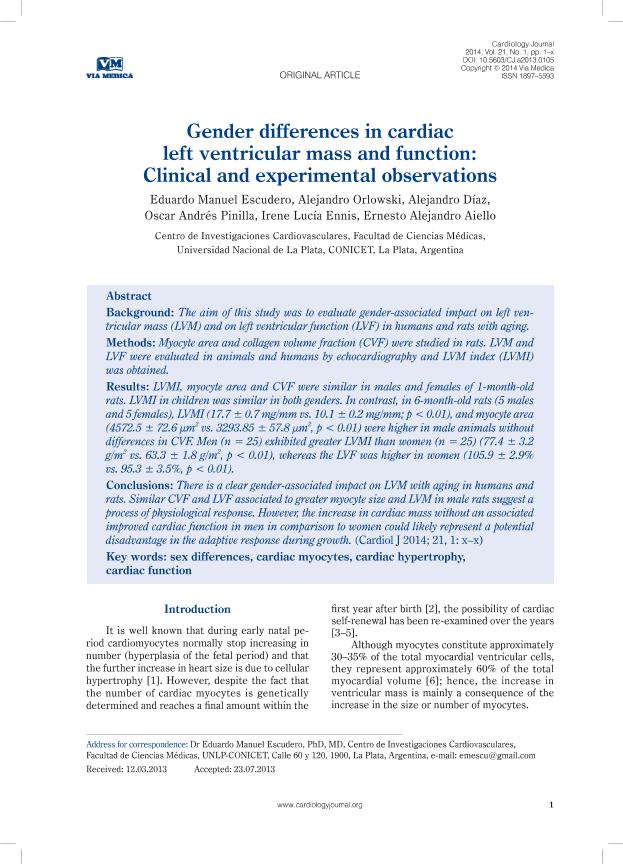Artículo
Gender differences in cardiac left ventricular mass and function: clinical and experimental observations
Escudero, Eduardo Manuel; Orlowski, Alejandro ; Diaz, Alejandro; Pinilla, Oscar Andres
; Diaz, Alejandro; Pinilla, Oscar Andres ; Ennis, Irene Lucia
; Ennis, Irene Lucia ; Aiello, Ernesto Alejandro
; Aiello, Ernesto Alejandro
 ; Diaz, Alejandro; Pinilla, Oscar Andres
; Diaz, Alejandro; Pinilla, Oscar Andres ; Ennis, Irene Lucia
; Ennis, Irene Lucia ; Aiello, Ernesto Alejandro
; Aiello, Ernesto Alejandro
Fecha de publicación:
01/2014
Editorial:
Via Medica
Revista:
Cardiology Journal
ISSN:
1897-5593
Idioma:
Inglés
Tipo de recurso:
Artículo publicado
Clasificación temática:
Resumen
Background: The aim of this study was to evaluate gender-associated impact on left ventricular mass (LVM) and on left ventricular function (LVF) in humans and rats with aging. Methods: Myocyte area and collagen volume fraction (CVF) were studied in rats. LVM and LVF were evaluated in animals and humans by echocardiography and LVM index (LVMI) was obtained. Results: LVMI, myocyte area and CVF were similar in males and females of 1-month-old rats. LVMI in children was similar in both genders. In contrast, in 6-month-old rats (5 males and 5 females), LVMI (17.7 ± 0.7 mg/mm vs. 10.1 ± 0.2 mg/mm; p < 0.01), and myocyte area (4572.5 ± 72.6 μm2 vs. 3293.85 ± 57.8 μm2 , p < 0.01) were higher in male animals without differences in CVF. Men (n = 25) exhibited greater LVMI than women (n = 25) (77.4 ± 3.2 g/m2 vs. 63.3 ± 1.8 g/m2 , p < 0.01), whereas the LVF was higher in women (105.9 ± 2.9% vs. 95.3 ± 3.5%, p < 0.01). Conclusions: There is a clear gender-associated impact on LVM with aging in humans and rats. Similar CVF and LVF associated to greater myocyte size and LVM in male rats suggest a process of physiological response. However, the increase in cardiac mass without an associated improved cardiac function in men in comparison to women could likely represent a potential disadvantage in the adaptive response during growth. (Cardiol J 2014; 21, 1: x–x)
Palabras clave:
Cardiac Myocytes
,
Sex Differences
,
Cardiac Function
,
Cardiac Hypertrophy
Archivos asociados
Licencia
Identificadores
Colecciones
Articulos(CIC)
Articulos de CENTRO DE INVEST.CARDIOVASCULARES (I)
Articulos de CENTRO DE INVEST.CARDIOVASCULARES (I)
Citación
Escudero, Eduardo Manuel; Orlowski, Alejandro; Diaz, Alejandro; Pinilla, Oscar Andres; Ennis, Irene Lucia; et al.; Gender differences in cardiac left ventricular mass and function: clinical and experimental observations; Via Medica; Cardiology Journal; 21; 1; 1-2014; 53-59
Compartir
Altmétricas



